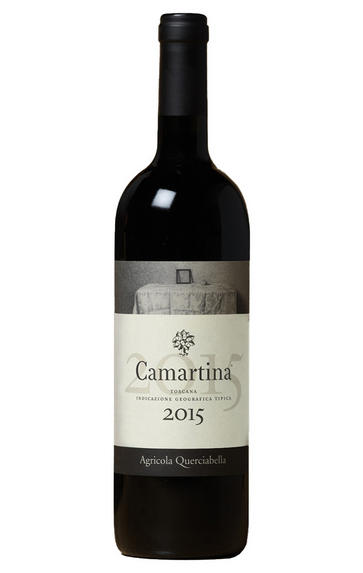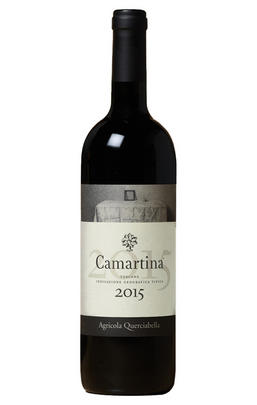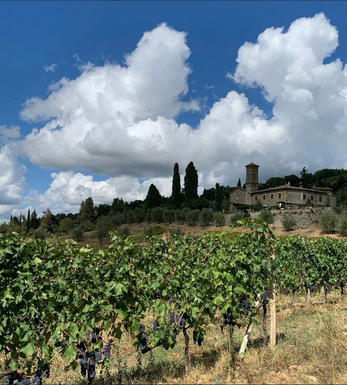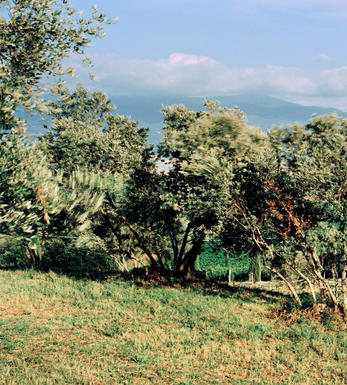
2015 Camartina, Querciabella, Tuscany, Italy

Critics reviews
Querciabella's flagship Camartina is flat-out stunning. Camartina is not a huge wine, as so many are in 2015, rather it possesses extraordinary finesse and elegance. Sweet floral notes, red berry fruit, mint and chalk notes give the 2015 soaring top notes, energy and vibrancy. Beautifully persistent and sculpted, the 2015 dazzles with its energy and overall intensity. There is so much to like here.
Drink 2025 - 2040
Antonio Galloni, vinous.com (Aug 2019)
Drink 2021 - 2030
Monica Larner, Wine Advocate (Apr 2021)
Bruce Sanderson, Wine Spectator (Oct 2020)
James Suckling, jamessuckling.com (Nov 2019)
About this WINE

Querciabella
The story of Querciabella, or its charming translation ‘beautiful oak’, started in 1974 when oenophile and businessman, Giuseppe (Pepito) Castiglioni brought the estate. The Castiglione family has always pushed boundaries, by planting non-indigenous grape varieties and converting their vineyards to Biodynamic farming.
Since 1981, Camartina has been the estate’s leading Super-Tuscan. Camartina is part of a revolutionary but highly select group of wines, which firmly elevated Italian wine to the world stage. The estate was unhappy with the mediocrity of the Tuscan region, which, in turn, sparked creativity and innovation amongst the best wineries. Querciabella took a risk when producing Camartina, as they eschewed the strict rules of the Chianti Classico region.
Originally, the blend of Camartina favoured Sangiovese but over the years, Cabernet Sauvignon has usurped the traditional, Tuscan grape variety. This is due to the Bordeaux variety acclimatising to Ruffoli’s sandstone slopes. French Oak is the material of choice for the fermentation vessels, creating integrated tannins in the wine. The Sangiovese and Cabernet Sauvignon wines are matured separately for 18 months in French Oak barrels. The leading barrels are selected to make up the final blend.

Tuscany
Responsible for only 6 percent of Italy's total wine production in 2006 (half that of the Veneto) Tuscany may not be a heavyweight in terms of quantity, but as the home of two of the country's most famous fine wines - Chianti and Brunello di Montalcino - it certainly holds its own in terms of quality.
Tuscany is Italy's most ancient wine region, dating back to the 8th century BC when the Etruscans developed the area in parallel with the Greeks, before ceding to the Romans. Along with building roads and sewers, they developed the region's viticultural potential, using wood for winemaking rather than amphorae, and passing their expertise onto their French neighbours. With the demise of Rome in the 5th century AD, the Longobards established Lucca as the capital of what was then known as Tuscia. Florence and Siena became banking and trading hubs during the Middle Ages, with Chianti – then a white wine – first documented in the 14th century.Tuscany passed from the Medicis to the Habsburgs as part of the Holy Roman Empire, and then onto the Austrian Empire before becoming part of a reunified Italy in 1861. The quality of Chianti was first recognised by the Grand Duke of Tuscany, Cosimo III, who classified its finest areas in 1716.
Located in the west-central part of the country with the Tyrrhenian Sea lapping its coastline, Tuscany's climate ranges from Mediterranean on the coast to continental deep in the Apennines. More than two thirds of the province is covered with hills, an important terroir factor in the production of fine Tuscan wine. The finest such areas are Chianti Classico, Chianti Rufina, Brunello di Montalcino, Vino Nobile di Montepulciano, Morellino di Scansano and Bolgheri. Sangiovese (in its various clones) is the black grape of choice.
Recommended producers: Valgiano, Caiarossa, Villa Calcinaia, Bibbiano, Badia a Coltibuono, La Serena, Scopetone, Lisini, Sesti, San Giuseppe, Cerbaiona.

Cabernet Sauvignon Blend
Cabernet Sauvignon lends itself particularly well in blends with Merlot. This is actually the archetypal Bordeaux blend, though in different proportions in the sub-regions and sometimes topped up with Cabernet Franc, Malbec, and Petit Verdot.
In the Médoc and Graves the percentage of Cabernet Sauvignon in the blend can range from 95% (Mouton-Rothschild) to as low as 40%. It is particularly suited to the dry, warm, free- draining, gravel-rich soils and is responsible for the redolent cassis characteristics as well as the depth of colour, tannic structure and pronounced acidity of Médoc wines. However 100% Cabernet Sauvignon wines can be slightly hollow-tasting in the middle palate and Merlot with its generous, fleshy fruit flavours acts as a perfect foil by filling in this cavity.
In St-Emilion and Pomerol, the blends are Merlot dominated as Cabernet Sauvignon can struggle to ripen there - when it is included, it adds structure and body to the wine. Sassicaia is the most famous Bordeaux blend in Italy and has spawned many imitations, whereby the blend is now firmly established in the New World and particularly in California and Australia.


Buying options
Add to wishlist
Description
Querciabella's flagship Camartina is flat-out stunning. Camartina is not a huge wine, as so many are in 2015, rather it possesses extraordinary finesse and elegance. Sweet floral notes, red berry fruit, mint and chalk notes give the 2015 soaring top notes, energy and vibrancy. Beautifully persistent and sculpted, the 2015 dazzles with its energy and overall intensity. There is so much to like here.
Drink 2025 - 2040
Antonio Galloni, vinous.com (Aug 2019)
wine at a glance
Delivery and quality guarantee